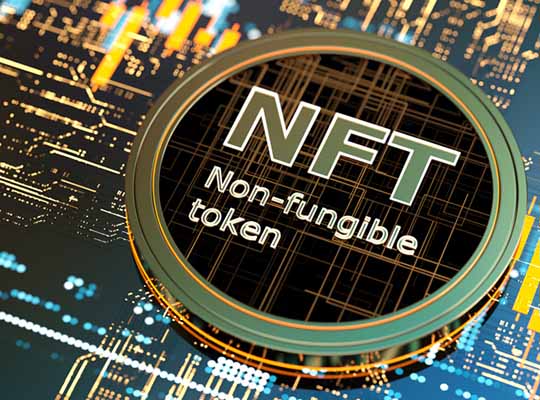A non-fungible token (NFT) is data attached to a file to establish a unique signature. It may be a picture file, music, a tweet, a piece of writing put on a website, or a real object. This essentially implies that someone may possess a digital file (as long as the file is tagged with a unique code that distinguishes it from any digital copies).
Non-fungible tokens (NFT)
- An Ethereum-based asset for everything unique.
- NFTs provide content producers greater control than ever before.
- Sponsored by Ethereum blockchain technology.
NFTs are now sweeping the worlds of digital art and collectibles. Big sales to a new crypto-audience are changing the livelihood of digital artists. Celebrities are jumping in, seeing a new way to interact with followers. One application of NFTs is digital art. They may indicate control of any unique asset, whether digital or tangible.
KEY TAKEAWAYS
- Fungibility refers to a product or asset’s capacity to be easily exchanged for another of like sort.
- Non-fungible goods and assets, such as owned automobiles and homes, are those that are not transferable.
- Money is an excellent example of a fungible asset since a $1 note may readily be converted into four quarters or ten dimes, for example.
In 2020, the market value of NFTs will have tripled to more than $250 million. NFT sales surpassed $2 billion in the first quarter of 2021. These goods cannot be substituted with other items due to their unique characteristics.
On the other hand, fungible objects may be traded since their worth characterizes them rather than their unique characteristics. For instance, ETH and dollars are fungible, meaning that 1 ETH / $1 may be exchanged for another 1 ETH / $1.
The internet of assets
NFTs and Ethereum address some of the internet’s current issues. Everyday things like scarcity, distinctiveness, and ownership evidence must be replicated in the digital world. And digital products typically only function inside their production environment. For example, you can’t resell an iTunes mp3 or swap reward points for a credit on another platform, even if the market exists.
Comparing an internet of NFTs to the internet most of us use every day…
A comparison
| An NFT internet | The internet today |
| NFTs are digitally distinct from one another; no two NFTs are identical. | A duplicate of a file, such as an.mp3 or.jpg, is identical to the original. |
| Each NFT must have an owner, which is public information and easily verifiable by anybody. | Digital goods’ ownership details are kept on institutional servers — take their word for it. |
| NFTs work with anything developed on Ethereum. An event’s NFT ticket may be exchanged on any Ethereum marketplace for another NFT. You may exchange art for a ticket! | A digital company must develop its infrastructure. Such as an app that provides digital tickets for events. |
| Content producers may sell their work globally and any place. | Creators rely on the platforms’ infrastructure and distribution. The usage of these is often restricted. |
| Creators may claim resale royalties instantly and maintain ownership rights. | Platforms like streaming services keep most of the sales proceeds. |
| Items have unexpected uses. Examples of decentralized loans using digital artwork as collateral. |
Non-Fungible Tokens
Cryptocurrency investment is maturing, and many trends are emerging to become the next big thing. In the ever-changing blockchain world, Non-Fungible Tokens (NFTs) are rapidly becoming a passive investment option. So popular are NFTs that renowned companies, celebrities, and investors are establishing or planning to start them.
Recent data shows how quickly NFTs are gaining popularity. In 2020, NFT sales totaled $250 million, and in the first quarter of 2021, $2 billion.
The truth is that not all NFTs are created equal. Before we go into the best methods to earn money using NFTs, let’s define NFT.
What is a Non-Fungible Token
Non-fungible commodities or assets are not interchangeable. It’s possessing or making something that can’t be replaced. Fungibles are interchangeable. Non-fungible tokens are data units recorded on a blockchain that certifies a digital asset as unique and non-transferable. You may think of them as a digital version of personal treasures with varying values.
How to create an NFT
Creating an NFT isn’t tricky, and there are sites where you can ask for help. A specific blockchain builds and supports NFTs, with Ethereum being the most prominent. Aside from Ethereum, Flow and Finance are also frequently utilized. Wallets and cryptocurrency, primarily Ethereum, are required. Smart contracts allow you to exchange NFTs for cryptocurrency or fiat cash.
Top Ways To Make Money With NFTs
There are many methods to earn money using NFTs. Take a look at these four methods that worked.
Digital Works of Art
Individual non-fungible token artworks are among the most popular and profitable non-fungible tokens produced to date. On March 11, 2021, an auction house sold artwork for a stunning $69 million. This was the auction house’s first digital art auction.
NFTs offer the artist ownership rights so that when they produce a digital asset, they can prove authenticity and benefit from their work. The originator of a meme gains as it spreads. From that viewpoint, NFTs are a breakthrough art technology.
Fashion NFTs
Like artwork, NFTs address authenticity and reduce counterfeiting. Featuring the NFT trend, clothing and fashion companies are increasingly benefitting from digital limited edition ensembles with celebrity items or design trademarks. Clothing and fashion companies may also profit from NFT development by creating an NFT marketplace for their products. That way, they may earn limitless income from NFTs safely and reliably.
Licensed Collectibles
Tokenizing collectibles is an excellent use of NFTs and the most apparent method to deal with collectibles. Those currently selling natural treasures like trinkets, souvenirs, trading cards, and other things may also sell digital assets. Because NFT can show rarity, collectibles may be worth much more than their physical equivalents.
Sports cards have been the most popular collectibles. First, only licensed footballer cards could be traded. The NBA has now created its own NFT card collection. Other sports are likely to follow, giving collectors a broader range of sport NFTs to choose from.
That doesn’t mean other collectibles are failing. As previously mentioned, tangible items may be tokenized and purchased, exchanged, or sold as such. While physical trade and handling may harm collectibles, NFTs never lose quality since they are exclusively kept digitally on the Blockchain.
Video Games
Video game NFTs are also taking form as Blockchain enables players to earn instead of paying to win. NFT game creation is the way to go to engage bigger audiences and improve income possibilities. The games enable you to purchase, sell, trade, or swap valuables. Although no popular games exist now, the potential is enormous.
Games are known to be significant spenders on virtual goods. Therefore games with NFTs sellable in-game items may be a big winner. Notably, NFT video game makers are aggressive NFT creators, which may advance NFT technology.
In-game NFTs are the most sophisticated compared to the artwork, fashion, and trading cards. Because they are sophisticated, completely interactive, and constantly altering as a player’s character evolves.
NFTs Features:
- Collectibles digital goods
- The value fluctuates according to what other people are ready to pay
- Security feature: unique data is added to a digital work
- You may buy, sell, trade, or gift NFTs to anybody online, but a network of computers must verify the transaction and the unique data.
Environmental Impact Of NFTs
NFTs, like other cryptocurrencies, have a significant environmental effect. NFT transactions must be confirmed through Blockchain to ensure the encryption is genuine, which uses vast amounts of energy. A digital-only artwork has fetched an eye-watering $69 million (£50 million) at Christie’s auction house – but the lucky bidder will not get a sculpture, painting, or even a print.
Final Thoughts: The Non-Fungible Future
Non-fungible Tokens do not seem to be a fleeting blockchain and cryptocurrency fad. With its many and innovative uses, it seems as if this technology has just scratched the surface. The fact that only essential pictures are popular demonstrates that nobody has fully realized the technology’s potential. As the popularity of NFTs continues to grow, it may develop more sophisticated tokens, enabling the NFT market to explode. Additionally, NFT engineers are rapidly developing breakthroughs for various industries. Thus far, many sectors such as real estate, media, and entertainment have benefited form NFTs.















